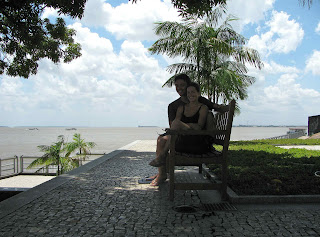A three-hour drive from Kourou, where the road ends, sits the beachside Awala Yalimopo nature reserve. The town itself isn’t much to look at: a restaurant that never opened, a local museum, and unimpressive surf the color of olives sitting out in the sun too long. Yet, every April to June, giant leatherback turtles that can grow up to 600kg, come here to lay their eggs. From June to September, the eggs hatch and the newborns struggle out to sea. When we arrived, we saw plenty of rubbery, white shells resembling broken ping pong balls scattered all over the beach and we planned to spend the whole afternoon watching and waiting to catch a glimpse of the cute little buggers. And wait we did. Six hours later the sun had set and mosquitoes were making Tia’s neck look like a dartboard so we decided to give up and head back to our car.
We did, however, make another little friend on the beach. A puppy, apparently the offspring of one of the numerous strays we passed, came crawling out of the brush toward us, tripped, and nearly collapsed onto the sand. His eyes were impossibly forlorn and he couldn’t even muster the energy to approach us in search of food. On the one hand, we wondered what to do, where to take him, whether we should worry about scabies (Claudia!), and how to explain him to anyone in a language where we could barely order food. On the other hand, here was a puppy who was clearly weak and clearly didn’t have anyone looking after him. We were torn. We fed him cashews and water, wandered up and down the beach, and eventually came up with a plan to take him to the auberge we were staying at where the owner (a.k.a. Tarzan) was known for taking care of abused, exotic animals. By the time we went to fetch him, though, it was dark and there was no sign of him anywhere. We searched around the nearby area but he had disappeared completely.
We slept restlessly that night and both admitted to thinking of him in silence for the first hour after we awoke. We kicked ourselves for missing our chance to help and now Bernard (Tia had named him sometime during the course of the day) was gone with little chance of surviving on his own. We resolved to drive the bumpy two hours back to Awala Yalimopo. We picked up dog food and a box to hold him in on our way there, confident we would find him now that it was day again.
We wish we could tell you that we had, that Bernard is living happily among the other animals at Tarzan’s auberge… An entire afternoon of combing up and down the beach, Tia calling his name plaintively while I whistled, yielded no sign of him. In a strange twist of fate, our exhaustive search for Bernard actually led us to two baby turtles struggling to free themselves from their sandy nests. They both had a long way to go – one of them was near dead – and we were able to put them into the ocean and watch them swim away.
Seeing baby turtles hatch in the wild has been on our wish list for quite some time, but seeing them without finding Bernard made for a bittersweet day.





















